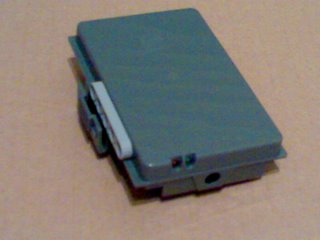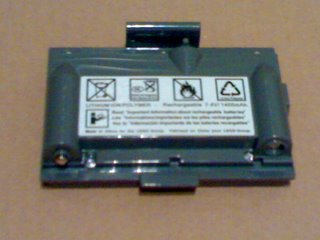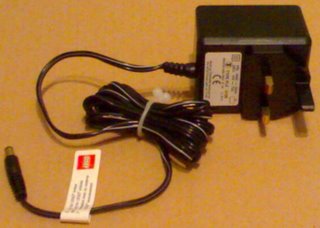For my first post I was going to put up photos of the inside of my NXT brick. Just two minor things stopped me:
1. I only have a picture of the top side of the circuit board, as I have not yet persuaded the battery terminals to become disconnected. (I guess I need a bigger bit for my soldering iron, and some extra hands to help pull when the solder is melted.)
2. Jürgen Stuber has just beaten me to it - http://www.jstuber.net/lego/nxt-programming/nxt-hardware.html
That I have disassembled my NXT so quickly will tell you something about me, for good or ill. In mitigation I must point out that the software arrived a day later than the hardware, and the temptation was great.
I shell visit the NXT internals later, but for now here is some info I have not seen covered elsewhere...
This is the rechargeable battery in the NXT Educational kit:
 Notice the light grey half width studless beam balanced on the lip of the battery; illustrating that the battery protrudes the whole height of the beam from the back of the NXT brick.
Notice the light grey half width studless beam balanced on the lip of the battery; illustrating that the battery protrudes the whole height of the beam from the back of the NXT brick.
The battery can be recharged whilst installed in the NXT, unless it is completely discharged.
The green LED illuminates when the transformer is connected, and the red LED whilst the battery is charging.
 The postive and negative terminals of the battery pack are at the bottom corners of this second picture.
The postive and negative terminals of the battery pack are at the bottom corners of this second picture.
Just inside these you can see two silver dots - some of the blind rivets keeping the housing sealed.
To the top, just before the clip that holds the battery pack inside the NXT, is a plastic pin that operates a button inside the NXT. Presumably the switch simply indicates that a rechargeable battery is fitted - perhaps in order to limit the power level to the motors?
 This is the UK charger, notice the only identification or label on the charger brick is on the side facing the wall. It does not even mention Lego, but has safety test symbols and describes the output as 10V ac 7VA.
This is the UK charger, notice the only identification or label on the charger brick is on the side facing the wall. It does not even mention Lego, but has safety test symbols and describes the output as 10V ac 7VA.
There is a Lego sticker on the wire, but that seems likely to be lost quite quickly in a classroom.
The other side of the sticker has symbols warning against connection to mobile phones, tape players and radios.
The printed instructions very strongly say not to use a non-Lego charger.
Tony
1. I only have a picture of the top side of the circuit board, as I have not yet persuaded the battery terminals to become disconnected. (I guess I need a bigger bit for my soldering iron, and some extra hands to help pull when the solder is melted.)
2. Jürgen Stuber has just beaten me to it - http://www.jstuber.net/lego/nxt-programming/nxt-hardware.html
That I have disassembled my NXT so quickly will tell you something about me, for good or ill. In mitigation I must point out that the software arrived a day later than the hardware, and the temptation was great.
I shell visit the NXT internals later, but for now here is some info I have not seen covered elsewhere...
This is the rechargeable battery in the NXT Educational kit:
 Notice the light grey half width studless beam balanced on the lip of the battery; illustrating that the battery protrudes the whole height of the beam from the back of the NXT brick.
Notice the light grey half width studless beam balanced on the lip of the battery; illustrating that the battery protrudes the whole height of the beam from the back of the NXT brick.The battery can be recharged whilst installed in the NXT, unless it is completely discharged.
The green LED illuminates when the transformer is connected, and the red LED whilst the battery is charging.
 The postive and negative terminals of the battery pack are at the bottom corners of this second picture.
The postive and negative terminals of the battery pack are at the bottom corners of this second picture.Just inside these you can see two silver dots - some of the blind rivets keeping the housing sealed.
To the top, just before the clip that holds the battery pack inside the NXT, is a plastic pin that operates a button inside the NXT. Presumably the switch simply indicates that a rechargeable battery is fitted - perhaps in order to limit the power level to the motors?
 This is the UK charger, notice the only identification or label on the charger brick is on the side facing the wall. It does not even mention Lego, but has safety test symbols and describes the output as 10V ac 7VA.
This is the UK charger, notice the only identification or label on the charger brick is on the side facing the wall. It does not even mention Lego, but has safety test symbols and describes the output as 10V ac 7VA.There is a Lego sticker on the wire, but that seems likely to be lost quite quickly in a classroom.
The other side of the sticker has symbols warning against connection to mobile phones, tape players and radios.
The printed instructions very strongly say not to use a non-Lego charger.
Tony